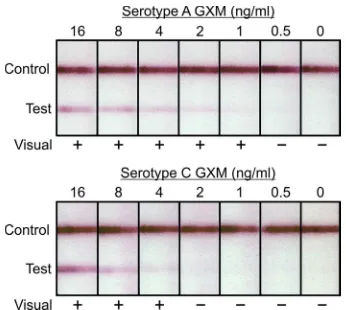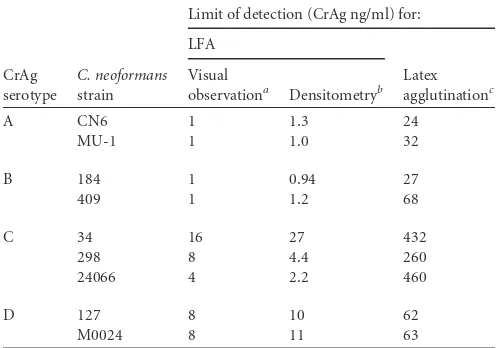Published Ahead of Print 30 January 2013.
10.1128/CVI.00732-12.
2013, 20(4):634. DOI:
Clin. Vaccine Immunol.
Marcellene A. Gates-Hollingsworth and Thomas R. Kozel
Immunoassay for Cryptococcal Antigen
Serotype Sensitivity of a Lateral Flow
http://cvi.asm.org/content/20/4/634
Updated information and services can be found at:
These include:
REFERENCES
http://cvi.asm.org/content/20/4/634#ref-list-1
This article cites 12 articles, 7 of which can be accessed free at:
CONTENT ALERTS
more»
articles cite this article),
Receive: RSS Feeds, eTOCs, free email alerts (when new
http://journals.asm.org/site/misc/reprints.xhtml
Information about commercial reprint orders:
http://journals.asm.org/site/subscriptions/
To subscribe to to another ASM Journal go to:
on March 25, 2013 by UNIV OF OKLAHOMA
http://cvi.asm.org/
Serotype Sensitivity of a Lateral Flow Immunoassay for Cryptococcal
Antigen
Marcellene A. Gates-Hollingsworth, Thomas R. Kozel
University of Nevada School of Medicine, Reno, Nevada, USA
To meet the needs of a global community, an immunoassay for cryptococcal antigen (CrAg) must have high sensitivity for CrAg of all major serotypes. A new immunoassay for CrAg in lateral flow format was evaluated and found to have a high sensitivity for detection of serotypes A, B, C, and D.
W
ith a global burden of more than 1 million cases annually, cryptococcosis has emerged as a leading cause of death in patients with HIV or AIDS, killing an estimated 500,000 people (estimate range, 100,000 to 900,000) each year in sub-Saharan Africa alone (1). Early diagnosis is critical to effective treatment (2). The high burden of cryptococcosis in resource-limited set-tings underscores the need for an affordable, sensitive, and equip-ment-free diagnostic and has resulted in the development of the cryptococcal antigen lateral flow assay (CrAg LFA), a rapid point-of-care (POC) immunoassay (3).The CrAg LFA (Immuno-Mycologics, Inc.) was constructed using monoclonal antibodies reactive with the capsular polysac-charide glucuronoxylomannan (GXM), the primary cryptococcal antigen (CrAg) that is shed during infection. The CrAg LFA has a dipstick format capable of detecting GXM in either serum or ce-rebrospinal fluid. GXM has variable levels of O-acetylation that contribute to serotype specificity and is classified into four major serotypes—A, B, C, and D (4). Although most cases of cryptococ-cosis are caused by isolates of serotype A, the need for sensitive diagnostics capable of detecting all four serotypes is emphasized by the report of serotype C infections in HIV patients in sub-Saharan Africa (5) and an increasing number of temperate regions reporting serotype B infections in otherwise healthy individuals (6). Moreover, serotype D is found with a high frequency in clin-ical cases in Europe (7–9). Several of the leading CrAg immuno-assays for cryptococcosis display serotype bias, having a markedly reduced sensitivity for serotype C (10). In this study, the CrAg LFA serotype sensitivity was evaluated using endpoints determined vi-sually and by densitometry scanning to determine the limit of detection, with GXM isolated from strains representing each of the four major serotypes.
The nine representativeCryptococcusstrains used in this study were selected on the basis of the chemotype and structure reporter groups typical of each of the four major serotypes (10,11). GXM was isolated from culture supernatant fluids as previously de-scribed (10). Assays were performed by inserting CrAg LFA dip-sticks into samples (100l) containing GXM that was serially diluted 2-fold from 32 ng/ml to 0.25 ng/ml in phosphate-buffered saline (PBS). Assays were allowed to develop for 10 min and then read in a blinded fashion by 4 different individuals instructed to evaluate tests as either positive or negative. The visual limit of detection was defined as the lowest concentration where at least 50% of observers stated the test was positive. Examples of LFAs tested with GXM from serotypes A and C are shown inFig. 1. Tests were then read via densitometry scanning with an ESE lateral flow
immunoassay reader (Qiagen, Inc.). The ESE reader generates quantitative data by performing a densitometer scan of the dip-stick, where test line width (mm) is plotted against signal intensity (mV). Results yielding the calculated area of each peak (mm · mV) were plotted against corresponding concentrations, and the slope was then used to calculate a limit of detection with an endpoint of 50 mm · mV.
The CrAg LFA showed high sensitivity for GXM from all four serotypes (Table 1). Comparing the visual limits of detection, the assay had the highest sensitivity for serotypes A and B, detecting GXM from two strains of each serotype at 1 ng/ml. Sensitivity levels for GXM of three serotype C strains were 16 ng/ml (strain 34), 8 ng/ml (strain 298), and 4 ng/ml (strain 24066). The sensi-tivity limits for GXM of serotype D strains M0024 and 127 were each 8 ng/ml. Endpoints based on densitometric scanning of strips
Received12 December 2012Returned for modification8 January 2013 Accepted19 January 2013
Published ahead of print30 January 2013
Address correspondence to Thomas R. Kozel, tkozel@medicine.nevada.edu. Copyright © 2013, American Society for Microbiology. All Rights Reserved. doi:10.1128/CVI.00732-12
FIG 1Representative examples of the cryptococcal antigen lateral flow assay (CrAg LFA) tested with serial dilutions of GXM from serotype A strain CN6 and serotype C strain 24066. Shown are results from blinded visual inspection of strips by four independent observers. A positive (⫹) result is reported when 50% or more of the observers scored the result as positive.
634 cvi.asm.org Clinical and Vaccine Immunology p. 634 – 635 April 2013 Volume 20 Number 4
on March 25, 2013 by UNIV OF OKLAHOMA
http://cvi.asm.org/
were nearly identical to the visual results for serotypes A and B. Marginal differences were observed for serotype C and D samples. Overall there was a high correlation between limits of detection determined by visual inspection of the strips and limits of detec-tion determined by densitometric scanning (Pearson product-moment correlation coefficient, 0.95;P⫽0.00015). Despite the strong correlation between endpoints based on visual inspection and densitometric scanning, there was no obvious advantage in sensitivity determined by either method. Because the CrAg LFA is designed as a POC assay to be assessed without the use of equip-ment, densitometric scanning is not a substitute for direct obser-vation, but rather an added method to experimentally quantify signal levels and validate visual results. However, the ability to electronically capture results of POC testing is consistent with the goal of using such data for patient follow-up, quality control, and public health surveillance (12).
This study demonstrated that the CrAg LFA has high sensitivity for GXM of all four serotypes, with A⫽B⬎C⬎D. The observed sensitivity of the CrAG LFA was greater than we previously re-ported for currently available CrAg immunoassays in latex agglu-tination or enzyme immunoassay formats (10). The previously reported serotype sensitivity of the Immuno-Mycologics, Inc., la-tex agglutination assay (10), one of the most sensitive assays in either the latex agglutination or enzyme-linked immunosorbent assay (ELISA) formats, is shown for comparison purposes inTable 1. The mean increase in sensitivity across CrAg from all four se-rotypes was 40-fold using the LFA format relative to the Immuno-Mycologics latex agglutination assay. The increase in sensitivity was greatest with CrAg of serotype C strain 24066 (150-fold) and least with the CrAg of the two serotype D strains (7-fold).
The performance and cost effectiveness of this new assay have prompted two recent reports recommending the use of the CrAg LFA to screen severely immunodeficient patients (CD4⬍100
cells/l) (13,14). Screening would allow for early diagnosis and treatment of patients with subclinical infections. This study dem-onstrates the high sensitivity of the CrAg LFA for detection of GXM, further validating its use for prospective screening of pa-tients with HIV or AIDS and those presenting with clinical signs of cryptococcal meningitis.
ACKNOWLEDGMENTS
This study was supported by Public Health Service grants AI014209 and AI093365 from the National Institutes of Health.
The University of Nevada, Reno, has licensed monoclonal antibodies used for construction of the CrAg LFA to Immuno-Mycologics, Inc.
REFERENCES
1.Park BJ, Wannemuehler KA, Marston BJ, Govender N, Pappas PG, Chiller TM.2009. Estimation of the current global burden of cryptococcal meningitis among persons living with HIV/AIDS. AIDS23:525–530. 2.Cryptococcal Guideline Working Group WHO.2011. Rapid advice: diagnosis,
prevention and management of cryptococcal disease in HIV-infected adults, ad-olescents and children. World Health Organization, Geneva, Switzerland.http: //whqlibdoc.who.int/publications/2011/9789241502979_eng.pdf.
3.Jarvis JN, Percival A, Bauman S, Pelfrey J, Meintjes G, Williams GN, Longley N, Harrison TS, Kozel TR.2011. Evaluation of a novel point-of-care cryptococcal antigen test on serum, plasma, and urine from pa-tients with HIV-associated cryptococcal meningitis. Clin. Infect. Dis.53: 1019 –1023.
4.Wilson DE, Bennett JE, Bailey JW.1968. Serologic grouping of Crypto-coccus neoformans. Proc. Soc. Exp. Biol. Med.127:820 – 823.
5.Litvintseva AP, Thakur R, Reller LB, Mitchell TG.2005. Prevalence of clinical isolates ofCryptococcus gattiiserotype C among patients with AIDS in sub-Saharan Africa. J. Infect. Dis.192:888 – 892.
6.Centers for Disease Control and Prevention.2010. Emergence of Cryp-tococcus gattii—Pacific Northwest, 2004 –2010. Morb. Mortal. Wkly. Rep.
59:865– 868.
7.Dromer F, Mathoulin S, Dupont B, Letenneur L, Ronin O, French Cryptococcosis Study Group.1996. Individual and environmental fac-tors associated with infection due toCryptococcus neoformansserotype D. Clin. Infect. Dis.23:91–96.
8.Kwon-Chung KJ, Bennett JE.1984. Epidemiologic differences between the two varieties ofCryptococcus neoformans. Am. J. Epidemiol.120:123– 130.
9.Tortorano AM, Viviani MA, Rigoni AL, Cogliati M, Roverselli A, Pagano A.1997. Prevalence of serotype D inCryptococcus neoformans isolates from HIV positive and HIV negative patients in Italy. Mycoses
40:297–302.
10. Percival A, Kozel TR, Thorkildson P. 2011. Monoclonal antibodies specific for immunorecessive epitopes of glucuronoxylomannan, the ma-jor capsular polysaccharide ofCryptococcus neoformans, reduce serotype bias in an immunoassay for cryptococcal antigen. Clin. Vaccine Immunol.
18:1292–1296.
11. Bacon BE, Cherniak R, Kwon-Chung KJ, Jacobson ES.1996. Structure of theO-deacetylated glucuronoxylomannan fromCryptococcus neofor-mansCap70 as determined by 2D NMR spectroscopy. Carbohydr. Res.
283:95–110.
12. Reid A.2012. Bringing the lab to the patient: developing point-of-care diag-nostics for resource limited settings. American Academy of Microbiology, Washington, DC.http://academy.asm.org/index.php/colloquium-program /browse-all-reports/495-bringing-the-lab-to-the-patient-developing-point -of-care-diagnostics-for-resource-limited-settings-2012.
13. Rajasingham R, Boulware DR.2012. Reconsidering cryptococcal antigen screening in the U.S. among persons with CD4⬍100 cells/mcL. Clin. Infect. Dis.55:1742–1744.
14. Jarvis JN, Govender N, Chiller T, Park BJ, Longley N, Meintjes G, Bekker LG, Wood R, Lawn SD, Harrison TS.2012. Cryptococcal antigen screening and preemptive therapy in patients initiating antiretroviral ther-apy in resource-limited settings: a proposed algorithm for clinical imple-mentation. J. Int. Assoc. Physicians AIDS Care (Chic.).11:374 –379.
TABLE 1Limit of detection of CrAg LFA for detection of GXM of different serotypes and comparison to previous report of sensitivity of latex agglutination assay
CrAg serotype
C. neoformans strain
Limit of detection (CrAg ng/ml) for:
LFA
aLowest concentration at which 50% of observers considered a test to be positive. b
Limit of detection calculated on the basis of densitometry scanning with an electronic reader.
c
Latex agglutination data are from a previous report of the serotype sensitivity of the Immuno-MycologicsCryptococcusantigen latex agglutination test system (10).
CrAg Immunoassay
April 2013 Volume 20 Number 4 cvi.asm.org 635

